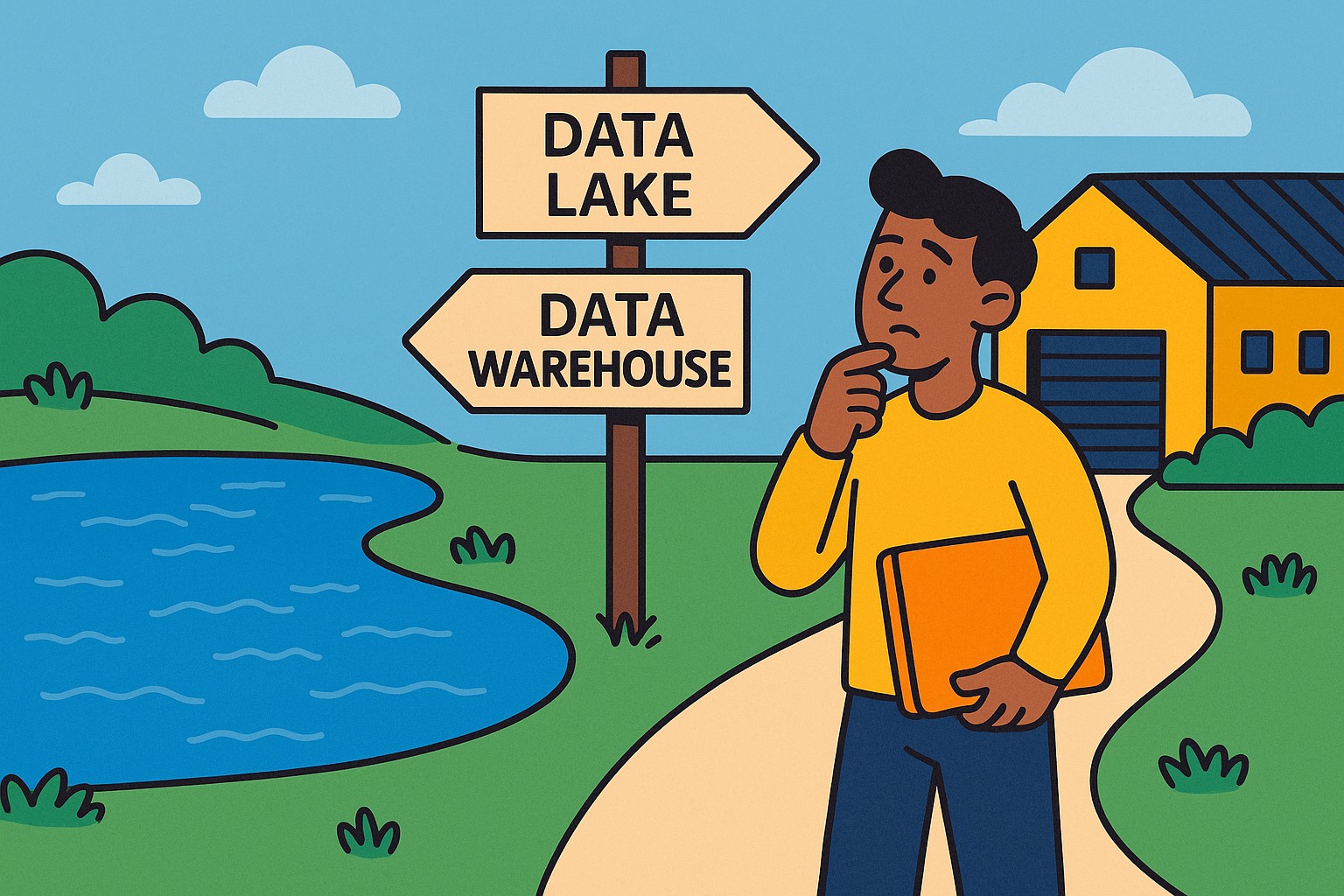The Journey from On-Premise to Cloud-Based Data Warehousing
The landscape of data management is witnessing a seismic shift as businesses transition from on-premises solutions to cloud-based architectures. While data warehouses have served as the bastions of structured data storage and analytics for decades, their role is undergoing a significant metamorphosis in the age of digital transformation. "Every company is now a tech company," says Andrew Ng co-founder and lead of Google Brain, reflecting on the digitization sweeping across industries.
Yet, this transformation is not merely a technological upgrade; it's a complete rethink of data strategy and business intelligence. As you ponder the complexities of Big Data, real-time analytics, and the ever-growing regulatory constraints, it becomes evident that your data warehouse—often the nucleus of enterprise data management—needs more than just a facelift. It needs a new operational environment that can adapt, scale, and evolve. That environment, for a myriad of reasons we'll discuss, is the cloud.
Migrating a data warehouse to the cloud is not a tactical maneuver but a strategic enterprise decision that can profoundly impact an organization's agility, scalability, and cost-effectiveness. This comprehensive guide aims to navigate you through this intricate process, focusing on best practices and critical considerations that can mean the difference between a successful migration and an operational nightmare.
Why Migrate to the Cloud?
In the traditional data warehousing landscape, the focus was primarily on handling structured data, using on-premises servers that required significant investment in hardware and manpower. However, the era of Big Data and real-time analytics has brought forth new challenges that traditional systems find hard to accommodate. As Marc Andreessen co-founder of Netscape Communications Corporation, pointed out, "Software is eating the world," and in our context, cloud-based systems are becoming the devourer of Big Data.
One of the key drivers for cloud migration is scalability. Traditional data warehouses require a huge upfront investment for hardware that might soon become obsolete or insufficient. With cloud-based solutions, you can start small and scale your data storage and processing capabilities in line with business growth. This scalability also extends to computational power. Cloud-based data warehouses like Amazon Redshift or Google BigQuery allow you to add computational nodes as your data processing requirements grow, all without the need to invest in additional hardware.
Another compelling reason is cost-efficiency. The pay-as-you-go model of cloud solutions eliminates the need for capital expenditure and allows for more flexible operational expenditure. You're essentially moving from a CAPEX model to an OPEX model, which offers more leeway in managing finances.
Moreover, the cloud offers geographical flexibility. With a workforce that is increasingly global, having a data warehouse that can be accessed from anywhere in the world is a tremendous asset. Cloud-based solutions offer this flexibility, ensuring that remote teams can access data just as easily as those based at headquarters.
Business Alignment and Objectives
Data warehousing is not just an IT initiative; it’s a business initiative. Therefore, its alignment with overall business objectives cannot be overstated. Suppose the company aims to enhance customer experience. In that case, the data warehouse should be geared to quickly process large amounts of customer data for analytics that can provide actionable insights into customer behavior and preferences.
However, business objectives aren't constant; they evolve. The advantage of a cloud-based system here is agility. Businesses can pivot more easily if their technology stack is agile. The ability to quickly adapt to market changes or to shift business focus is crucial in today's fast-paced business environment, and cloud-based data warehouses excel in this aspect.
This alignment is not solely the responsibility of the IT department. It's a multi-departmental endeavor that involves key decision-makers from finance, operations, and even human resources. For instance, if one of the business objectives is cost-cutting, the finance department needs to be actively involved in the migration plan to determine how the move will impact the organization’s finances in both the short and long term.
It's also important to remember that no single department can have a complete view of the organization's goals and objectives. As tech visionary Steve Jobs once said, "Great things in business are never done by one person; they're done by a team of people." Therefore, aligning your data warehouse migration with business objectives is a collective endeavor that necessitates cross-functional planning and execution.
By understanding why cloud migration is essential and how it aligns with your broader business objectives, you set the stage for a more effective, efficient, and strategic migration process. These initial phases are not mere checkboxes to tick off but are, in fact, crucial steps that lay the groundwork for a successful migration.
Conducting a Needs Assessment
Prior to any migration, conducting a readiness assessment is non-negotiable. You need to thoroughly evaluate your existing system's capabilities, as well as its shortcomings. This involves auditing your current data workflows, understanding the types of data you store, and how this data is consumed across the organization. The results of this assessment serve as the foundation upon which the rest of the migration plan is built.
Choosing the Right Data Migration Method
There are several strategies for migration, such as the straightforward "Lift and Shift," where applications and data are moved to the cloud without modifications, or "Replatforming," which involves making slight tweaks to adapt to the cloud environment. Your choice between these methods will significantly influence the speed, cost, and overall success of your migration. Thus, it’s crucial to weigh the pros and cons of each, keeping the needs assessment results in mind.
Selecting a Cloud Service Provider
The marketplace is teeming with cloud service providers, each offering a unique set of services and pricing models. Vendor selection should be guided by compatibility with your existing systems, service offerings tailored to your needs, and of course, cost-effectiveness. While the temptation to opt for a cheaper provider is understandable, consider the long-term implications of vendor lock-in. As Werner Vogels, CTO at Amazon.com, emphasizes, "Scalability is bigger than any one piece of technology," hence your cloud service provider should offer the scalability to evolve with your growing business needs.
In-depth Look at Architectural Choices
When migrating to the cloud, one of the primary decisions you'll face is choosing between a cloud-based Data Lake and Data Warehouse. Your choice will depend on your organization’s needs for structured versus unstructured data, and how you intend to query that data. The architecture also includes considerations like the transition from monolithic systems to microservices, which offer more agile and scalable data workflows. Furthermore, the debate between stream and batch processing comes into play, each with its own set of advantages and drawbacks in a cloud environment.
Data Modeling and Schema Design
Moving to the cloud also presents an opportunity to reevaluate your data modeling approach. The flexibility of schema-on-read versus schema-on-write models can significantly impact how quickly your organization can adapt to new data sources and types. Similarly, whether you opt for data normalization or denormalization can affect query performance and storage costs. These decisions should be made meticulously, considering both current and future data analytics needs.
Data Governance and Compliance
Migration to the cloud brings its set of governance challenges, especially when dealing with regulations like GDPR and CCPA. As part of your migration strategy, establishing a strong data governance framework is crucial. This framework should cover aspects like data quality, auditing, and compliance checks to ensure that you are not only storing but also processing data in a legally compliant manner.
Security Measures
Security in the cloud is a different ball game altogether. You're dealing with challenges ranging from data breaches to unauthorized access. The key is to implement robust API security measures and employ encryption techniques that make data breaches extremely unlikely.
Cost Assessment and Budgeting
Finances are inevitably a major concern when considering migration. As Tom Redman, the data quality guru, pointed out, "The 'hidden' costs of bad data are higher than you think." Therefore, it’s essential to evaluate not just the immediate costs of migration but also the long-term operational expenses. This includes estimating the total cost of ownership (TCO) and calculating the return on investment (ROI) to ensure that the migration financially justifies itself in the long run.
Risk Assessment and Mitigation
Potential risks such as data loss, data corruption, and unplanned downtime can severely impact the migration process. Employing risk assessment tools like Failure Mode and Effect Analysis (FMEA) can help in preemptively identifying and subsequently mitigating these risks.
Data Migration Team
An optimal data migration team comprises a range of roles, from Project Managers and Data Architects to Cloud Specialists. Each role demands a unique set of skills, and assembling a team with these diverse competencies is vital to ensuring that your migration plan is well-rounded and robust.
Planning and Execution
Once all assessments are complete and the team is assembled, the next step is developing a detailed migration plan. This plan should include key milestones, such as initial assessment results, pilot testing phases, and the final migration schedule. Monitoring mechanisms should be put in place to continuously track the progress of the migration and make adjustments as required.
Data Verification and Validation
After migration, the verification of data completeness and integrity is paramount. Benchmarks should be established to compare post-migration performance metrics against those from the pre-migration phase. Any discrepancies should be promptly addressed to ensure that the migrated data is both complete and reliable.
Post-Migration Optimization
Post-migration, it's essential to continue monitoring system performance and make necessary adjustments. Machine learning and AI can be leveraged for intelligent data management tasks, enabling the system to adapt to data patterns and user demands more efficiently.
Charting the Future Post Cloud-Based Data Warehouse Migration
Migrating a data warehouse to the cloud is akin to a complex ballet performance, where each component—be it scalability, security, or cost—must move in perfect harmony with the others. It is a journey that requires meticulous planning, a clear understanding of organizational goals, and a robust execution strategy. While the migration process might seem daunting, the payoff is immense. You're not just moving data from point A to point B; you're transforming how your organization thinks about and utilizes its most valuable asset—data.
"The future is much like the present, only longer," says Dan Quisenberry, emphasizing that what we do today sets the stage for what comes next. By making a strategic move to migrate your data warehouse to the cloud, you are effectively setting the stage for a more flexible, scalable, and cost-efficient future. You are not only preparing your organization to meet the current demands of Big Data and real-time analytics but also equipping it to adapt to challenges and opportunities that we can't even envision yet.
In this guide, we've explored multiple facets of the migration process—from business alignment and architectural choices to risk assessment and post-migration optimization. Each section serves as a building block for the next, cumulatively contributing to what should be a well-thought-out and executed migration strategy. But remember, this is not the end; it's merely the beginning. Migration is the first step in a continuous process of adaptation and improvement in the ever-evolving landscape of cloud-based data management.
In closing, the journey from a traditional data warehouse to a cloud-based solution is more than a technological transition. It’s a transformative leap that can redefine your organization’s operational capabilities and strategic outlook. And in a world that’s rapidly going digital, that’s not just an advantage; it’s a necessity.
 is now
is now


